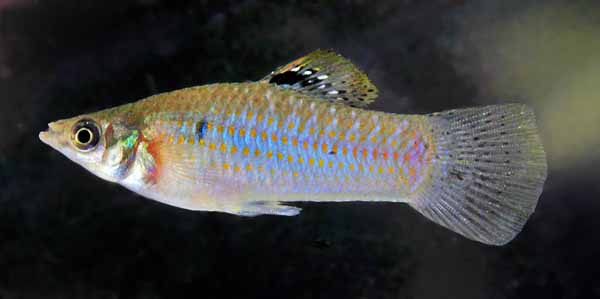Poecilia (Mollienesia) gillii
(Kner, 1863)
|
Familie: Poeciliidae SynonymeXiphophorus gillii Kner, 1863
Lokale Bezeichnung |
 Poecilia (Mollienesia) gillii ♂ (Panama, Panamá Oeste, Capira) -- (c) Samuel Valdes; iNaturalist; BY-NC-ND 4.0 |
Typen
Holotypus: ZSM 176 [alte Sammlung] zerstört im 2. Weltkrieg.
Siehe: Eschmeyer, W.N., Fricke, R. & Van der Laan, R. (eds.) 2024. Catalog of Fishes electronic version
Typusfundort: Río Chagres, Panama.
Etymologie
Patronym nicht identifiziert, aber fast sicher zu Ehren des Smithsonian-Zoologen Theodore Gill (1837-1914). (Übersetzt aus: The ETYFish Project)
Verbreitung
Abflüsse in den Atlantik von Guatemala bis zum Río Térraba, Costa Rica. Río Grande, Provinz Coclé, bis zum Río Bayano, Panama.
IUCN Status

EX Extinct (ausgestorben)
EW Extinct in the Wild (in der Natur ausgestorben)
CR Critically Endangered (vom Aussterben bedroht)EN Endangered (stark gefährdet)
VU Vulnerable (gefährdet)
NT Near Threatened (potenziell gefährdet)
LC Least Concern (nicht gefährdet)
RE Regionally Extinct (regional oder national ausgestorben)DD Data Deficient (ungenügende Datengrundlage)
NE Not Evaluated (nicht beurteilt)
Status: Stand 9.09.2023: DD Data Deficient (ungenügende Datengrundlage)
Gefahren für diese Art: Bestehende und künftige Bedrohungen für diese Art können angesichts der taxonomischen Unsicherheit und der damit verbundenen Ungewissheit über die Verbreitung dieser Art nicht im Detail bewertet werden.
Literatur
- Kner, R. 1863. Eine Uebersicht der ichthyologischen Ausbeute des Herrn Professors Dr. Mor. Wagner in Central-Amerika. Sitzungsberichte der Königlich Bayerischen Akademie der Wissenschaften zu München 1863 (2): 220–230. Zitatseite [:224, "Fig. 9" (wurde nicht veröffentlicht), !!, als Xiphophorus gillii]
- Kner, R. & Steindachner, F. 1864. Neue Gattungen und Arten von Fischen aus Central-Amerika; gesammelt von Prof. Moritz Wagner. Abhandlungen der Bayerische Akademie der Wissenschaften, Mathematisch-Physikalische Classe, München, 10 (1. abth.): 1-61, Pls. 1-6. Zitatseite [:25, Pl. 4 (fig. 1), Zeichnung, Beschreibung, als Xiphophorus gillii]
- Rosen, D.E. & Bailey, R.M. 1963. The poeciliid fishes (Cyprinodontiformes), their structure, zoogeography, and systematics. Bulletin of the American Museum of Natural History, 126 (1): 1-176. (Handle) Zitatseite [:49, als Synonym von Poecilia sphenops]
- Fromm, D. 1977. Expedition nach Costa Rica. Die Aquarien- und Terrarienzeitschrift (DATZ), 30(7): 227; (8): 262. Zitatseite [:227]
- Villa, J. 1982. Peces nicaragüenses de agua dulce. Colleccion Cultural, Serie Geografía y Naturaleza, No. 3. Fondo de Promoción Cultural, Banco de América. 253pp. Zitatseite [:134, gültig als Poecilia gillii]
- Werner, U. 1982. Zum Fischfang nach Costa Rica (I). Die Karibikflüsse der Provinz Limon. Das Aquarium, #156, (6): 294-299. Zitatseite [1982/06:295*|sw-Foto, Vorkommen]
- Bussing, W.A. 1987. Peces de las aguas continentales de Costa Rica, (1. Auflage). Universidad de Costa Rica, San José, 271pp. Zitatseite [:145, Beschreibung]
- Chapman, L.J. & Chapman, C.A. 1993. Desiccation, flooding, and the behavior of Poecilia gillii (Pisces: Poeciliidae). Ichthyological Exploration of Freshwaters, 4 (3): 279-287. Zitatseite [1993/03:279ff, Verhalten, Vorkommen]
- Seeger, K. & Dost, U. 1993. Poecilia gillii. Ein äußerst variabler Lebendgebärender aus Costa Rica. Das Aquarium, #291, 27 (9): 15-17. Zitatseite [1993/09:15ff|Vorkommen, Beschreibung, Fortpflanzung, Farbfoto]
- Dost, U. & Seeger, K. 1994. Lebendgebärende aus Costa Rica. Die Aquarien- und Terrarienzeitschrift (DATZ), 47 (8): 485-488. Zitatseite [1994/08:485f|Farbfoto, Vorkommen]
- Baensch, H.A. & Riehl, R. 1995. Aquarien Atlas, Band 4 (1. Auflage). Mergus Verlag, Melle. 864pp. Zitatseite [:520, Farbfoto]
- Dost, U. 1998. Poecilia gillii (KNER & STEINDACHNER, 1863) - ein in Costa Rioca weit verbreiteter Lebendgebärender. Aquaristik Aktuell, (7-8): 54-55. Zitatseite [1998/07:54-55, Farbfoto, Vorkommen, Fortpflanzung, Aquarienhaltung]
- Bauermeister, M. 1998. Costa Rica. Aquaristische Eindrücke zwischen Karibik und Pazifik. Das Aquarium, #354, 32 (12): 24-29. Zitatseite [1998/12:27*, Farbfoto, Vorkommen]
- Keijman, M. 1999. Bijvissen uit Midden-Amerikaanse cichlidenbiotopen. Cichlidae, 25 (3): 81-88. Zitatseite [1999/03:88*, Farbfoto, als Poecilia salvatoris]
- Meyer, M.K. 2000. Weltneuheit: Der Apfelsinen-Molly. Aquarium Heute, 18 (4): 644-646. Zitatseite [2000/04:645|Farbfoto]
- Weixler, R. & Weish, P. 2002. Im "Regenwald" der Österreicher. Die Aquarien- und Terrarienzeitschrift (DATZ), 55 (9): 34-38. Zitatseite [2002/09:35*|Farbfoto]
- Poeser, F.N. 2003. Geographic variation in Poecilia Bloch and Schneider, 1801 (Teleostei: Poeciliidae), with descriptions of three new species and designation of lectotypes for P. dovii Günther, 1866 and for P. vandepolli van Lidth de Jeude, 1887. Proceedings of the Biological Society of Washington, 116 (2): 356-379. (BHL) Zitatseite [2003/02:48, Beschreibung, als Poecilia sphenops gillii]
- Poeser, F.N. 2003. Taxonomy of Poecilia Bloch and Schneider, 1801. Pp 130-170 in: From the Amazon R. to the Amazon molly and back again. The evolution and systematics of the genus Poecilia Bloch and Schneider, 1801. Chapter 11 (Thesis). Zitatseite [:163, als Poecilia gillii]
- Ho, A.L.F.C., Pruett, C.L. & Lin, J. 2016. Phylogeny and biogeography of Poecilia (Cyprinodontiformes: Poeciliinae) across Central and South America based on mitochondrial and nuclear DNA markers. Molecular Phylogenetics and Evolution, 101: 32-45. (doi) Zitatseite [:Fig. 1, in Untergattung Mollienesia]
- Palacios, M., Voelker, G., Rodriguez, L.A., Mateos, M. & Tobler, M. 2016. Phylogenetic analyses of the subgenus Mollienesia (Poecilia, Poeciliidae, Teleostei) reveal taxonomic inconsistencies, cryptic biodiversity, and spatio-temporal aspects of diversification in Middle America. Molecular Phylogenetics and Evolution, 103: 230-244. (doi) Zitatseite [:232]
- Huber, J.H. 2019. A nomenclatural and systematic Analysis of livebearing Cyprinodontiformes (Acanthopterygii: Anablepsinae, Goodeinae, Poeciliidae). Killi-Data Series, 2019: 4-155, 3 tabs., 8 figs. (WWW) Zitatseite [:101]
- Sosna, E. 2023. Alarmstufe "Rot". Amatitlania kanna steht auf der "Roten Liste". Amazonas, #108, 19 (4): 18-25. Zitatseite [:22*, Farbfoto, Biotop]
- Sosna, E. 2023. Rückkehr ins Paradies: Costa Rica Teil 1. Amazonas, #106, 19 (2): 50-59. Zitatseite [:56*, Farbfoto, Biotop]
- Sosna, E. 2023. Rückkehr ins Paradies: Costa Rica Teil 2. Amazonas, #107, 19 (3): 52-59. Zitatseite [:57*, Farbfoto, Biotop]